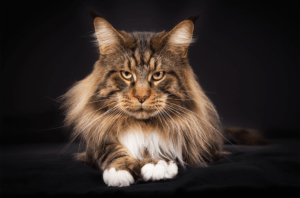Feline Hyperthyroidism

Hyperthyroidism is one of the most common problems seen in middle-aged and older cats. The average age of onset is 13. It’s an insidious disease that results in many other related afflictions due to the increased level of thyroid hormone, T4, released from the paired thyroid glands located in the laryngeal, or upper, area of the neck. This T4 is then changed into the active thyroid hormone, T3, by tissues in the body. Hyperthyroidism, if not treated, can result in irrecoverable damage to the kidneys, liver and heart. However, if diagnosed early and treated, these associated diseases can be minimized. Recognizable symptoms include weight loss with increased appetite, polydipsia or increased water consumption, polyuria or increased urine output, unusual vocalization, hyperactivity and sometimes chronic vomiting and diarrhea. The hair coat can become matted and/or greasy. These symptoms are subtle at first, but become more significant as the disease progresses. Hyperthyroid cats can be demanding, even obnoxious in their desire for food and treats.
The actual cause of feline hyperthyroidism has not been completely elucidated. However, dietary factors and chemicals in the food or the cat’s environment likely are contributing factors to initiating the disease.
It’s vitally important to discuss even subtle symptoms with your veterinarian, as the sooner this disease is identified, the better it is for long term health. During the physical examination, the doctor may be able to determine if either of the glands is enlarged. Diagnosis involves testing of the blood for increased T4 hormone (two specific tests). In some cats, these levels may be within the normal ranges. If hyperthyroidism is still suspected, other more involved and specific tests will be required.
Treatment
There are currently four treatment options for hyperthyroidism in cats: radioactive iodine therapy, medication, dietary therapy and surgical removal of the affected thyroid glands.
Radioactive iodine is the treatment of choice for cats with this disease. This treatment involves an injection of a medication that is highly regulated and must be administered in a facility that is specially licensed to use the product. The treatment does not require anesthesia, but does require the cat remain in the hospital until the radioactive material has been eliminated by the body to acceptable levels for the safety of any person or animal that will be in contact with the treated cat. A special litter is often required for a period of time after the cat comes home. Also, it’s important to know that radiographs, and a negative FeLV and FIV test are usually required pre admission. RI is curative in around 95% of cats treated. In a small percentage of cases, hypothyroidism occurs requiring medication to maintain thyroid levels.
Medications (Methimazole or similar) currently available do not actually treat the disease, but interfere with the way the thyroid hormone is changed in the body to a utilizable form. It can certainly help hyperthyroid cats, but requires twice a day treatment and periodic blood testing to ascertain that the levels are within acceptable levels. In cases where cats cannot be given oral medication due to their personalities, a transdermal cream can be applied to the ears twice daily, but monitoring of the thyroid levels may need to be done more frequently. It takes 2-4 weeks to lower the T4 levels to acceptable limits.
Dietary control of hyperthyroidism is controversial, but Hills has developed a specific diet (Y/D) for control. According to research, 90% of cats fed this diet exclusively (no other food or treats can be fed) developed normal thyroid levels within 3 weeks. In my experience, the diet was well tolerated if the cats would eat it. It certainly is a worthwhile choice and can take the place of other treatment modalities.
Surgical removal of the thyroid glands can be a consideration, but the cost and benefits of this treatment may not make it a good choice due to the potential side effects related to the surgery. Radioactive iodine, in most cases, will be a less invasive and more cost effective choice with a diminished chance for post treatment problems.
See the following articles for more detailed information:
https://veterinarypartner.vin.com/default.aspx?pid=19239&id=4951398
Diet:
https://veterinarypartner.vin.com/default.aspx?pid=19239&id=5305366
